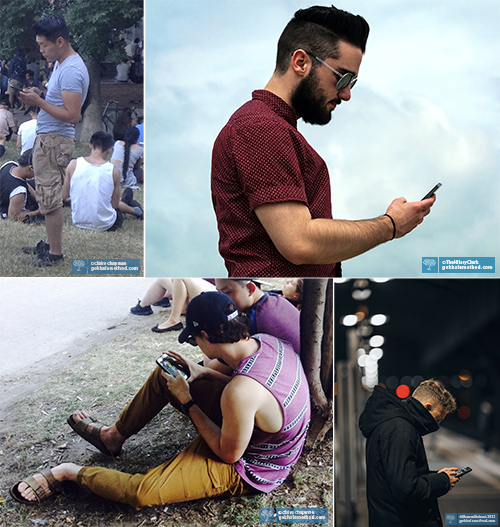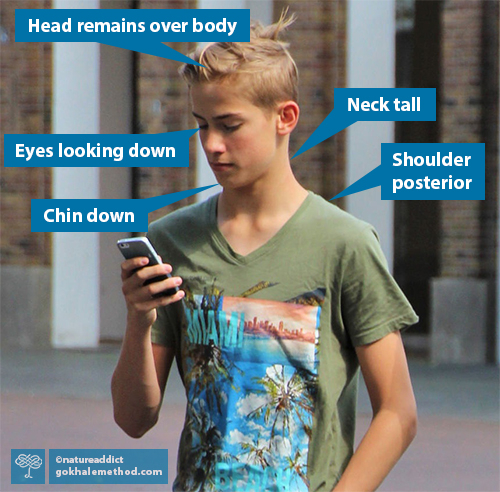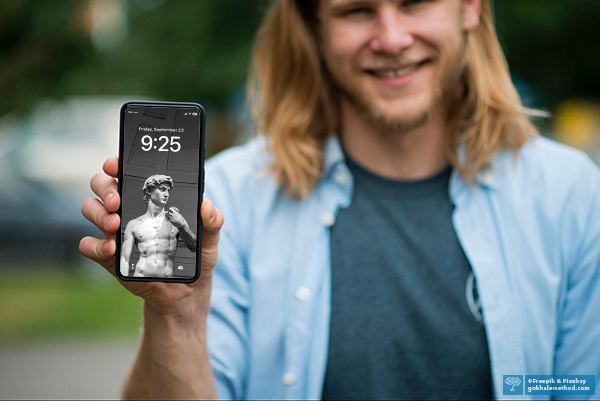Three Ways Your Cell Phone Can Save Your Neck
Yes, you read that correctly. Not only do you not need to damage your neck every time you use your cell phone, but instead, you could be improving it!
Most of us use our cell phones quite frequently. If you train yourself to adopt a healthy stance every time you use your phone, you will have a built-in posture practice that repeats throughout your day.
Identifying the problem

Cell phones are unfairly regarded as the inevitable cause of neck problems and slouching. It’s not that you use a phone, but how you use it, that matters. Images from Clare Chapman, Pixabay and Pexels
Most people tend to let their head be drawn towards their screen when they use their cell phone. That’s why social media and wellness features are full of warnings about “text neck,” including graphics about how the head gets effectively heavier the further forward it is, and how that puts increasing strain on the neck. This is certainly true. The advice to avoid text neck is often to hold your phone straight ahead, rather than downward. Since this is physically and socially awkward, most people don’t do it.

Common advice to hold a cell phone straight out ahead feels awkward to most people.
Fortunately, there is a better solution…
Neck Saver #1: Adjust your head, bring your phone to your face, and look down
I like to use an analogy with eating...You may have been trained to bring your food to your mouth, rather than your mouth to your plate. Your mother was right! Following the code of table manners, she was teaching not only a more elegant, but also a more healthful way of dining which avoided squishing your neck.

Infants instinctively like to keep their neck tall and head well aligned. Pexels
Similarly, when you use your phone, you want to first establish a healthy head and neck position, and then feed yourself your information by bringing the phone towards your face, rather than your face to your phone. We recommend you get started by watching this free video, which will teach you the basics of how to glide your neck back and up to a healthy baseline position.
Next, you will want to look down. Blaming a downward line of vision for neck problems ignores the reality that for tens of thousands of years our ancestors have looked downward, without any ill effects, and that we are fully adapted to do this. We’ve looked downwards to track animals, avoid snakes, find food, avoid thorns, make tools, prepare food, nurse infants, and more—these activities were essential, often for many hours at a time.
It may be enough to just move your eyes to look down. To look down further, you may need to do a combination of angling your chin down, and/or angling your neck from its base—where the bump of your largest neck bone (C7) may protrude at the back of your neck. No matter how you are looking downward, with your eyes, neck, or head, be sure your neck maintains a good baseline length.

The aim is not to avoid looking down, but to improve how we look down. This teenager has his eyes down, his chin down, and has maintained a tall, spacious neck which remains centered over his body. Image from Pixabay
Neck Saver #2: Get some new wallpaper!
It’s true that a picture is sometimes worth a thousand words. Our species has a very large visual cortex—by choosing a home screen on your cell phone that inspires and reminds you to reposition your neck, you will be reinforcing healthy neck posture every time you pick up your phone.

A little posture know-how turns your cell phone into a smartphone! Image from Freepik
We have put together a selection of downloadable images for you to choose from below.

Smartphone image #1. Image from Pixabay
Download image #1

Smartphone image #2
Download image #2

Smartphone image #3
Download image #3
Neck Saver #3: PostureTracker™
If only you could be reminded instantly every time your neck migrated forward or your chin jutted upward. Well, we have your back—and neck! Our recently released PostureTracker™ device uses a pair of sensors you can place in many pairs of locations on your body. Via an app on your phone, it gives you real-time feedback (visual, sound, or vibration) every time you depart from your calibrated ideal. No more over-contracting your neck muscles and compressing your cervical discs!
![]()
When your chin lifts, compressing your neck (left), PostureTracker will alert you and guide you back to your healthiest calibrated posture (right).
We are often asked why we do not sell the PostureTracker as a stand-alone device. It’s because without training, the device would likely be used to reinforce common misconceptions about good posture; people would use the device to “sit up straight,” for example, and likely do more harm than good. So PostureTracker is available only to our students, past and present. For people who understand what good posture is, the device is invaluable—it helps close the gap between knowing what to do and doing it as a habit. You can sign up here for our next Alumni PostureTracker Course, starting Thursday June 27, 7:00 am PT.
Best next action steps
If you have had trouble with your neck and would like to improve it, get started by booking a consultation, online, or in person with one of our teachers.
You can sign up below to join any one of our upcoming FREE Online Workshops…

Comments
Add New Comment
Login to add commment
Login